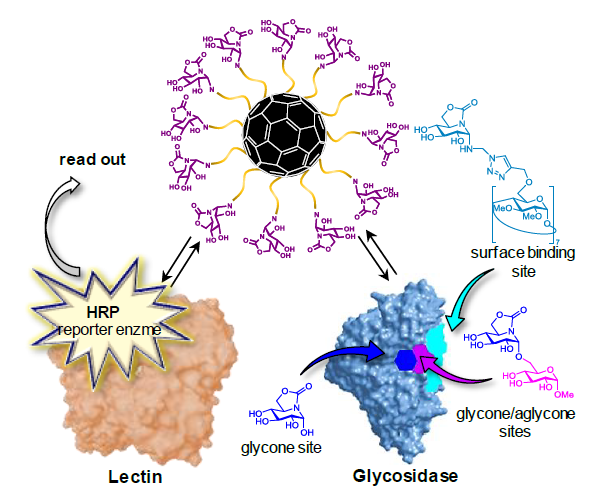The importance of the role played by carbohydrates in the multivalent or glycoside cluster effect drove recent innovative glycochemistry as reflected by the ever-growing number of papers in the field. An impressive range of glyco-architectures has been conceived to imitate what is thought to be the glycan coating of cells, to target complementary protein receptors, such as lectins. However, the implications of most of these realisations are limited as they rarely address the heterogeneity and the fluidity of the densely glycosylated cell membrane. They also neglect the impact that high-density nanosized arrangements could have in the interactions with the whole spectrum of carbohydrate-interacting proteins, among which glycosidases are notable representatives.
For many years the dogma assumed that: (i) efficient recognition by lectins generally requires high densities of the putative primary ligand and (ii) the mechanisms governing binding of a carbohydrate motif by a lectin or a glycosidase are disparate. However, this paradigm is becoming questioned seriously by an increasing amount of pieces of evidence. Secondary “innocent” ligands can play important roles in recognition of hetero-glyco-cluster constructs by lectins through synergistic or antagonistic contributions; a phenomenon termed the hetero-cluster effect.

The inhibition of certain glycosidases by glycomimetic- and, even more disturbing, the multivalent enzyme inhibition by glyco-coated architectures demonstrate the existence of multivalent effects and call for a generalised multivalent effect. Such an effect would govern the supramolecular chemistry of carbohydrate or glycomimetic structures in the biological context. Furthermore, this (hetero)multivalency would act as a multimodal switcher to drive the encoded information through different pathways. The authors of the article review the advancements made in the last few years in the understanding of the mechanisms underpinning the generalised multivalent effect. They emphasise the potential risks and opportunities derived from (hetero)-multivalency-elicited promiscuity.




